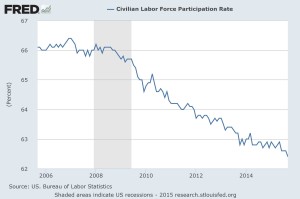The United States unemployment rate now stands just above five percent, though the real jobless figure is in the teens. The Federal Reserve-induced economic expansion continues, and everyone is rejoicing. But is the labor market really in such a rosy state?
A new report from the Goldman Sachs Group suggests that the unemployment rate will dip below 4.5 percent by the end of 2018 as a growing number of people will drop out of the workforce.
Today, the labor force participation rate, or the share of the working population, is at a 37-year low (SEE: U.S. labor force participation rate falls to 1977 levels at 62.6%). The share of the U.S. population in the workforce – individuals over 16 who have a job or who are looking for a job – declined to 62.4 percent last month.
There has been a strong debate over the past couple of years as whether the trend of a falling workforce participation is part of a potential long-term shift in the overall economy or the business cycle. Whatever the case, the Goldman Sachs analysts say the trend won’t reverse because an exponential number of Baby Boomers are retiring.

“The retired share of the population has increased more than we expected,” Goldman economists Jan Hatzius and David Mericle said in a report that was obtained by Newsmax. “There has been an increase in the share of prime-age workers who report that they do not want jobs.”
According to the report, the labor force participation rate will dip each year by a quarter of a percent for the next several years. Due to the fact that individuals who exit the workforce are not counted as unemployed by the U.S. Bureau of Labor Statistics (BLS), the unemployment rate will continue the downward trend. (SEE: Americans not in the labor force could exceed number of people working by 2017.)
This is important data for the Federal Reserve when it debates whether or not to raise interest rates.
“The downward revision to our participation forecast has directionally hawkish implications for monetary policy,” according to Goldman. “At the margin, this is consistent with the greater desire to start normalizing the funds rate that many Fed officials have recently expressed. it is also worth keeping in mind that our results still show a considerable amount of remaining labor market slack, which is consistent with the continued softness of wage and price inflation.”
Some say the only areas of the economy that are growing are ones that rely on government transfer payments or Fed stimulus.
Leave a Comment